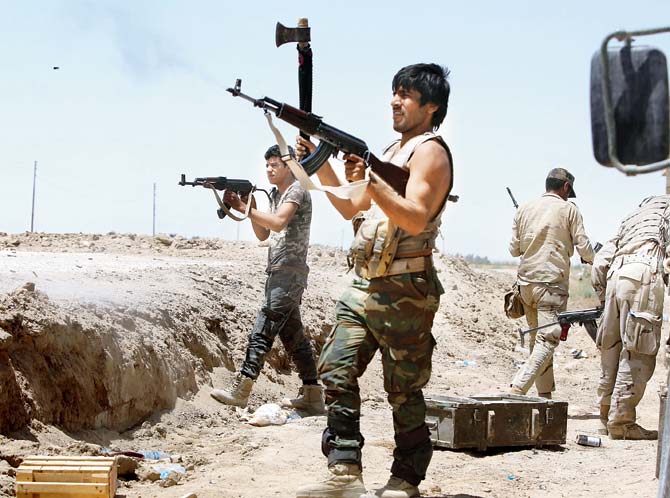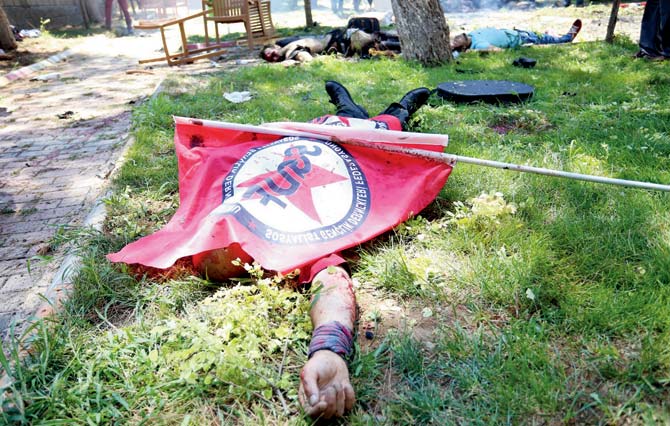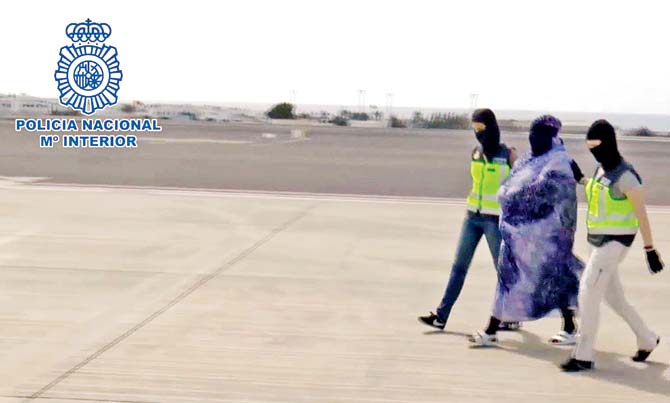As terror throws its long shadows across the world and we face a fight for our very existence, an in-depth look at how a terror organization rose from the ashes to brutalise the world

Afghan girls
After the death of Zarqawi, the Islamic State in Iraq had been handed setback after setback. When Abu Omar al Baghdadi, head of the ISI, was killed in 2010, it marked a turning point. ISI’s new leader was born Ibrahim Awwad Ibrahim Ali al-Badri al Samarrai, but he operated under the nom de guerre Abu Bakr al Baghdadi.

LOST INNOCENCE: Afghan girls who fled from Kot district of the eastern Nangarhar province, following threats from the IS to leave their homes, look around a corner next to their temporary homes in Jalalabad. IS fighters ordered families whose members were working for the government or Afghan National Security Forces to leave their homes
ADVERTISEMENT
His life story is ambiguous, sparse on details, and few of those uncontested. He was reportedly born in 1971 to a Sunni Arab family in the Iraqi city of Samarra, a city just north of Baghdad, His family was said to be directly descended from the Prophet Muhammad.
According to a disputed but widely distributed biography published under a pseudonym by Turki al Binali, a Bahraini national who joined ISIS, Baghdadi was born into an observant Salafi family and “his brothers and uncles include preachers and teachers.”

GUN HOUR: Iraqi Shiite fighters supporting the Iraqi government forces fire towards Islamic State (IS) group positions. PICS/AFP
According to Abu Ali, a neighbour of the family, Baghdadi remained in Samarra until he was eighteen, when he moved to Tobchi, a poor neighbourhood on the outskirts of Baghdad. He lived in a rundown apartment attached to the local mosque and reportedly enrolled in the Islamic University of Baghdad, eventually receiving a doctorate in Islamic culture and Shariah law. Abu Ali described him as a “quiet person, and very polite,” but also a “conservative practitioner of Islam.” He was said to have led prayers at the local mosque from time to time.

GORY STORY: This photo shows bodies on the ground after an explosion in the town of Suruc, on July 20, 2015, not far from the Syrian border. At least 20 people were killed and dozens injured, with the origin of the explosion not immediately determined, but many authorities and Turkish media claiming the attack to be carried out by a suicide bomber
During this period, Baghdadi was also a classmate of Ahmed al Dabash, who later became the leader of the Islamic Army of Iraq, a Sunni Arab insurgent group. Dabash remarked that the young Baghdadi “did not show much potential.” He described Baghdadi as “quiet, and retiring. He spent time alone… He was insignificant.”
Baghdadi reportedly led a quiet life until the United States and its allies invaded Iraq. In 2003, Baghdadi is believed to have begun on the path of jihad.

CAUGHT: A capture take from a video provided by Spanish Interior Ministry shows a woman who was arrested on July 7, 2015 on the Canary Islands and suspected of recruiting girls and teenagers for the Islamic State group, escorted by two Spanish policewomen on a tarmac
Jamaat Jaysh Ahl al Sunnah wa-al Jamaah (the Army of the Sunni People Group) was an insurgent group operating in Samarra, Diyala, and Baghdad. Baghdadi was a cofounder and the head of the group’s Shariah committee.
In late 2004 or early 2005, an American-led raid on a home near Fallujah led to the capture of many high-level insurgents and a man who was described as an “apparent hanger-on.” The latter was registered at Camp Bucca detention center as Ibrahim Awad Ibrahim al Badri.
There are conflicting accounts of Baghdadi from his time in Camp Bucca. A Pentagon official described him as “a street thug when we picked him up in 2004,” a characterisation that seems inconsistent with his background.
Andrew Thompson, who served at one of the US-run detention centres in Iraq, wrote an article with Jeremy Suri, a professor at University of Texas at Austin, arguing that the structure of Camp Bucca facilitated further radicalization among the prisoners.
Before their detention, Mr. al-Baghdadi and others were violent radicals, intent on attacking America. Their time in prison deepened their extremism and gave them opportunities to broaden their following. At Camp Bucca, for example, the most radical figures were held alongside less threatening individuals, some of whom were not guilty of any violent crime. Coalition prisons became recruitment centres and training grounds for the terrorists the United States is now fighting...
Small-time criminals, violent terrorists and unknown personalities were separated only along sectarian lines. This provided a space for extremists to spread their message. The detainees who rejected the radicals in their cells faced retribution from other prisoners through “Shariah courts” that infested the facilities. The radicalisation of the prison population was evident to anyone who paid attention. Unfortunately, few military leaders did.
In 2007, Major General Douglas Stone became the deputy commanding general of Multi-National Forces in Iraq with responsibility for in-country interrogation and detention. In this capacity, he was responsible for detainees at Camp Cropper, Camp Bucca, and Camp Ashraf. He spent the following year reforming prison conditions and installing innovative deradicalisation, rehabilitation, and reintegration techniques, which expedited the release of low-risk prisoners and appeared to reduce recidivism.
Most of the individuals taken into detention did not need to remain for long periods of time, or in many cases should not have been there in the first place, he told us. Many were not jihadists, but were unemployed civilians paid or coerced into joining the resistance. More than 80 per cent of the detainees tested illiterate and were largely ignorant about Islam, which made them particularly susceptible to recruitment while in prison.
In interviews for this book, General Stone recounted the reintegration process:
We studied the detainees, their tribal affiliations, their education level, their employment skills, their purported crimes, their leadership skills, and the extent to which they subscribed to jihadi principles. We decided to separate the hard-core jihadists from the casual insurgents. Our biggest worry was that the real jihadists were using the prison as a terrorist training camp. We wanted to release the individuals who shouldn’t have been there, or who could be easily reintegrated into Iraqi society, as quickly as possible. We hired one hundred and fifty imams from around the globe to preach mainstream Islam. We offered them job training. After a couple of years, we were able to release most of the prisoners, with less than two percent ever returning to the fight. That left only the true problem cases. Only about five thousand were left. The majority were either former regime Baathists, former criminals, or serious takfiri ideologies, followers of Zarqawi’s extreme beliefs regarding declaring other Muslims to be apostates. Even in American detention these takfiris were killing other detainees, cutting their eyes out, and trying to impose a version of Shariah that most Muslims would find quite abhorrent.
Baghdadi’s time in detention would only have made him more effective, General Stone said, pointing out that the individuals who spent time in Guantanamo pose a similar problem. Jihadists who get out of US detention develop a kind of aura when reintegrated into their home communities, he said, making it easier for them to recruit others, or to symbolise defiance against a Western power.
Baghdadi was probably systematically organising while he was in detention. Building up IOUs, getting to know whom to trust. He must have been plotting while he was incarcerated — he must have planned the whole rollout of the Islamic State...
If you look at how Badghdadi has set up the top leadership of ISIS, you can see how skilled he is. The guys at the top are all very skilled managers. Many of them are former Ba’athists. And to me a most important thing — he’s actually designated someone to run ISIS detainee operation. He learned, from being in detention himself, that if you don’t manage the prison well, the detainees will just organise themselves against you. And sure enough, his strategy has been to recruit his cadres from the prisons where jihadis were detained. He knows that's where to find hard-core radicals. But even if Baghdadi is ultimately replaced, the ideas that he is promoting will be with us a long time.
Baghdadi left Camp Bucca as an outspoken jihadi and immediately joined the ranks of the ISI, then under the leadership of Abu Omar al Baghdadi.
When a United States-Iraqi joint air strike targeted and killed Zarqawi's successors in April 2010, it wiped out the ISI’s senior leadership. With its leadership in disarray and its relevance waning, ISI sought out a leader with both religious authority and a track record of strategic successes.
Abu Bakr al Baghdadi fit these criteria. His education in Islamic law far exceeded the leaders of al Qaeda. Osama bin Laden studied business in college, his degree was reportedly in public administration. Ayman al Zawahiri was a surgeon. And the strength of Baghdadi's strategies would soon become clear.
In May 2010, he ascended to lead the Islamic State in Iraq (ISI). Baghdadi's first priority after becoming leader was his own personal safety. With ISI in shambles, Baghdadi set out to rebuild the organisation, eliminating potential critics and replacing them with trusted allies, many of whom spent several years with Baghdadi in Camp Bucca.
Among them were several Ba’athist leaders. Although AQI and ISIS are motivated by an ideological commitment to reviving, an Islamic state based on their understanding of the Shariah, they formed an alliance with the former Ba’athists, who had lost their jobs and status thanks to de-Ba’athification. According to some reports, the “Ba’athification” of ISIS may have been the brainchild of a former colonel in Saddam Hussein's army who spent time with Baghdadi at Camp Bucca.
“In the early days of the alliance the Ba’athists may have had the upper hand as they brought military and organisation skills and a network of experienced bureaucrats that AQI and then ISI lacked,” says Richard Barrett of the Soufan Group.
The Ba’athists became a critically important part of the ISID. Baghdadi chose many of them to full top organisational positions, including Abu Muslim al Turkmani, who became Baghdadi’s second in command (until he was reportedly killed in late 2014), and the senior leader of the military council, Abu Ayman al Iraqi. According to Barrett, atleast eight of ISI’s senior leadership members are former inmates at Camp Bucca.
Learning from past leaders’ mistakes, Baghdadi disguised his identity from the earliest days, even in the presence of his closest advisors. Abdul Rahman Hamad, an ISIS fighter who spoke to Time magazine stated, “(he) knew how men can be seduced by money, so he never shared his secrets with anyone.” He became known among his men as the “invisible sheikh” or the “Ghost.” With between 800 and 1,000 fighters in his ranks, Baghdadi would lead Iraq into its deadliest years since 2008.
Under Baghdadi’s leadership, ISI escalated its violence throughout 2010 and 2011, including using coordinated suicide attacks in several locations on the same day. In October 2011, the US Rewards for Justice program instated a reward of up to $10 million for information leading to the arrest or capture of Baghdadi.
By July 2012, in an atmosphere of growing sectarianism fueled in no small part by the policies of Prime Minsiter Maliki, Baghdadi had rebuilt the organization so substantially that he apparently felt no qualms about publicly announcing his next move — a campaign called, “Breaking Down the Walls,” in which Baghdadi promised to liberate Iraqi prisons overflowing with insurgents and jihadists.
Using covert channels to communicate with prisoners in advance, ISI spent the next year making good on Baghdadi’s promise. The insurgents attacked eight prisons using improvised explosives. They freed hundreds of prisoners, many of whom were senior leaders of ISI and its predecessors, or experienced fighters who subsequently joined the organisation. During the same one-year period, Baghdadi had courted the wrath of Al Qaeda by declaring an expansion of the ISI into neighbouring Syria, which was now engulfed in civil war. In defiance of al Qaeda’s emir, Ayman al Zawahiri, the Islamic State in Iraq was to be known as the Islamic State in Iraq and Syria, using the now notorious acronym ISIS.
From the ashes of near-total defeat, a new and virulent jihadist idea had emerged, and it aimed to terrorise the world with its brutal ambition.

Book: ISIS: The State of Terror
Authors: Jessica Stern and JM Berger
Published by: Harper Collins
Price: Rs 450
 Subscribe today by clicking the link and stay updated with the latest news!" Click here!
Subscribe today by clicking the link and stay updated with the latest news!" Click here!







